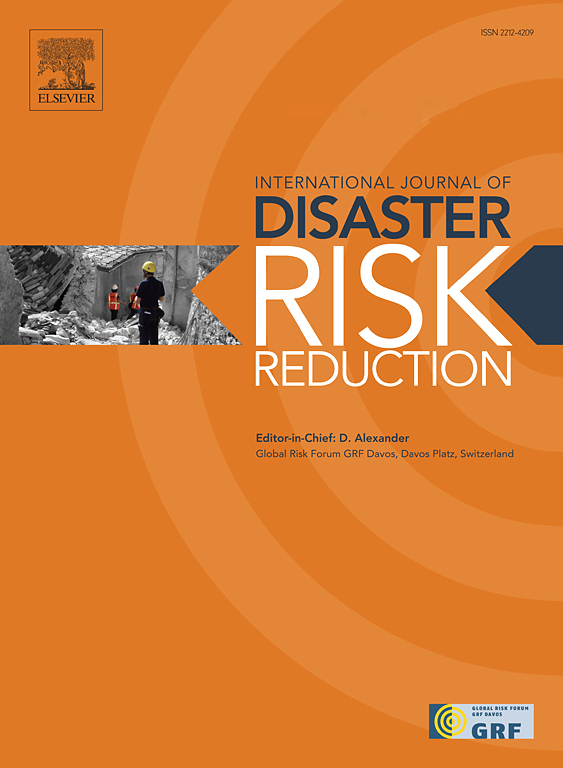Exploring local responses to coastal risks in Khulna City slums: Towards strengthening resilience
IF 4.2
1区 地球科学
Q1 GEOSCIENCES, MULTIDISCIPLINARY
International journal of disaster risk reduction
Pub Date : 2025-02-26
DOI:10.1016/j.ijdrr.2025.105349
引用次数: 0
Abstract
Climate change is intensifying risks for coastal cities like Khulna, Bangladesh, making them especially vulnerable to cyclones, storm surges, sea level rise, flooding, waterlogging, saltwater intrusion, etc. Despite this, there is limited focus on how slum dwellers in Khulna respond to these hazards and adapt. Understanding their vulnerabilities and coping mechanisms is crucial for effective climate risk management. This study found 60% of slum residents are climate migrants who migrated from nearby disaster-affected areas such as Koyra and Paikgacha. Around 34% of the total respondents were found to be illiterate, while 43% of households live below the poverty line. The slums were found to be densely populated, with many residents coming from large families, and small-scale businesses were an important source of income for many. Principal component analysis (PCA) identified two major issues in the study area: flooding-related problems and salinity-related challenges. Regression analysis explored that increased flooding disrupts locals’ daily activities, causes infrastructure damage, and leads to economic crises, while salinity hazards aggravate long-term vulnerabilities. This study identified two types of adaptive solutions: resource-intensive solutions (e.g., drainage system improvement) and low-cost, locally managed solutions (e.g., social engagement), both of which could effectively ensure in-situ resilience and sustainability in slum communities. The critical insights from this study could contribute to resilience and sustainable planning efforts, particularly in disaster risk reduction for coastal cities.
气候变化加剧了孟加拉国库尔纳等沿海城市的风险,使其特别容易受到气旋、风暴潮、海平面上升、洪水、内涝、盐水入侵等的影响。尽管如此,人们对库尔纳贫民窟居民如何应对和适应这些灾害的关注却很有限。了解他们的脆弱性和应对机制对于有效的气候风险管理至关重要。本研究发现,60% 的贫民窟居民是气候移民,他们从附近受灾害影响的地区(如 Koyra 和 Paikgacha)迁移而来。受访者中约有 34% 是文盲,43% 的家庭生活在贫困线以下。贫民窟人口稠密,许多居民来自大家庭,小型企业是许多居民的重要收入来源。主成分分析(PCA)确定了研究地区的两大问题:与洪水有关的问题和与盐分有关的挑战。回归分析发现,洪水的增加扰乱了当地人的日常活动,造成基础设施破坏,并导致经济危机,而盐碱危害则加剧了长期的脆弱性。本研究确定了两类适应性解决方案:资源密集型解决方案(如改善排水系统)和低成本、由当地管理的解决方案(如社会参与),这两类解决方案都能有效确保贫民窟社区的就地恢复能力和可持续性。这项研究得出的重要见解有助于提高抗灾能力和可持续规划工作,特别是在沿海城市减少灾害风险方面。
本文章由计算机程序翻译,如有差异,请以英文原文为准。
求助全文
约1分钟内获得全文
求助全文
来源期刊

International journal of disaster risk reduction
GEOSCIENCES, MULTIDISCIPLINARYMETEOROLOGY-METEOROLOGY & ATMOSPHERIC SCIENCES
CiteScore
8.70
自引率
18.00%
发文量
688
审稿时长
79 days
期刊介绍:
The International Journal of Disaster Risk Reduction (IJDRR) is the journal for researchers, policymakers and practitioners across diverse disciplines: earth sciences and their implications; environmental sciences; engineering; urban studies; geography; and the social sciences. IJDRR publishes fundamental and applied research, critical reviews, policy papers and case studies with a particular focus on multi-disciplinary research that aims to reduce the impact of natural, technological, social and intentional disasters. IJDRR stimulates exchange of ideas and knowledge transfer on disaster research, mitigation, adaptation, prevention and risk reduction at all geographical scales: local, national and international.
Key topics:-
-multifaceted disaster and cascading disasters
-the development of disaster risk reduction strategies and techniques
-discussion and development of effective warning and educational systems for risk management at all levels
-disasters associated with climate change
-vulnerability analysis and vulnerability trends
-emerging risks
-resilience against disasters.
The journal particularly encourages papers that approach risk from a multi-disciplinary perspective.
 求助内容:
求助内容: 应助结果提醒方式:
应助结果提醒方式:


